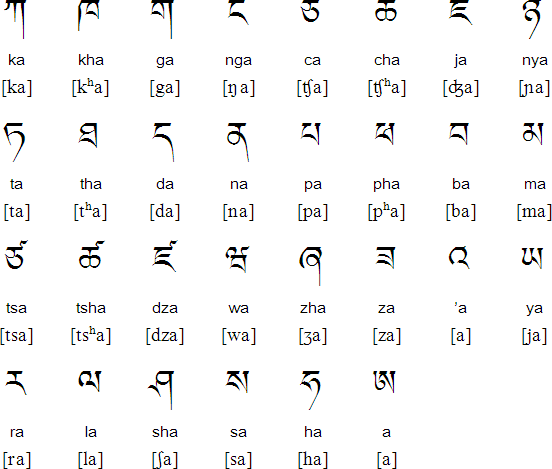TIBETAN SCRIPT
We will be using Wylie transliteration for all of the words.
Tibetan is an abugida, a segmental writing system in which consonant–vowel sequences are written as a unit: each unit is based on a consonant letter, and vowel is attached to the letter. Text goes from left to right.
Sample text:
བོད་ཀྱི་སྐད་ཡིག་ནི་བོད་ཡུལ་དང་ཉེ་འཁོར་གྱི་ས་ཁུལ་བལ་ཡུལ།
འབྲུག་དང་འབྲས་ལྗོངས།
ལ་དྭགས་ནས་ལྷོ་མོན་རོང་སོགས་སུ་བེད་སྤྱོད་བྱེད་པའི་སྐད་ཡིག་དེ།
ད་ཆར་ཡོངས་གྲགས་སུ་བོད་ཀྱི་ཡུལ་གྲུ་སྟོད་སྨད་བར་གསུམ་ལ་ལྟོས་ཏེ་ནང་གསེས་རིགས་གསུམ་དུ་ཕྱེ་བ་སྟེ།
སྟོད་དབུས་གཙང་གི་སྐད་དང་། བར་ཁམས་པའི་སྐད་དང་། སྨད་ཨ་མདོའི་སྐད་རྣམས་སོ།
བོད་སྐད་ནི་ཧོར་སོག་ལ་སོགས་པ་གྲངས་ཉུང་མི་རིགས་གཞན་པ་ཁག་ཅིག་གིས་བེད་སྤྱོད་གཏོང་བཞིན་ཡོད་པར་མ་ཟད།
བལ་ཡུལ་དང་། འབྲས་ལྗོངས། འབྲུག་ཡུལ་།
རྒྱ་གར་ཤར་དང་བྱང་རྒྱུད་མངའ་སྡེ་ཁག་གཅིག་བཅས་ཀྱི་རྒྱལ་ཁབ་རྣམས་སུའང་བེད་སྤྱོད་གཏོང་བཞིན་ཡོད།
How are these jumbled letters being read?
This is the list of letters of the Tibetan script.
This is the list of letters of the Tibetan script.
*Picture taken from Omniglot
But knowing those consonants aren't enough.
Vowels are also needed.
Vowels are added above or below the letter.
*Note: A word can only contain ONE vowel.
example:
ཀི /ki/, ཀུ /ku/, ཀེ /ke/, ཀོ /ko/
Knowing these vowels are still not enough...
The Tibetan script also contains consonant clusters or "stacked letters".
ཀི /ki/, ཀུ /ku/, ཀེ /ke/, ཀོ /ko/
Knowing these vowels are still not enough...
The Tibetan script also contains consonant clusters or "stacked letters".
Picture taken from BodyigBootCamp
Words in the Tibetan script contain :5 - prefix letter
3 - surmount letter
30 - root letter
4 - subjoined letter
4 - vowel
10 - suffix
2 - post suffix
1 - punctuation

4 - vowel
10 - suffix
2 - post suffix
1 - punctuation
Prefixes - not pronounced, but remove aspirated root characters and give a higher tone value to nasal root
characters
Surmount - not pronounced, appears in the superscript location raise the
tone pitch of the syllable. Each superscript character can only be used with a specified set of root
characters.
Root/Base - pronounced, can be modified by the subjoined letters.
Subjoin - appear below the root letter and modifies it.
Vowel - appears above or below the root
Suffix - has the following effects:
-
( ག ང བ མ འ ར ) add their own sound , eg. དག་ dag
-
modify the root's vowel ( ད ས ), eg. ནས nas - becomes /ne/
-
Post-suffix - appears after a suffix, does not modify the vowel nor the tone.
Punctuation - "tsheg" (་) used to separate a word from another word.
Now that you have an idea how the Tibetan script works.
here is an example
*Color coded for easier comprehension
Lets try a longer example.
pronounced:/bö-ki-ke-yig/ - meaning "Tibetan Language"

